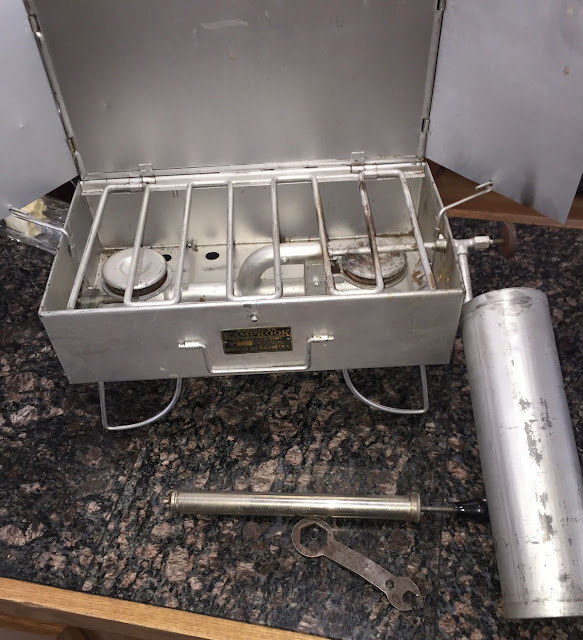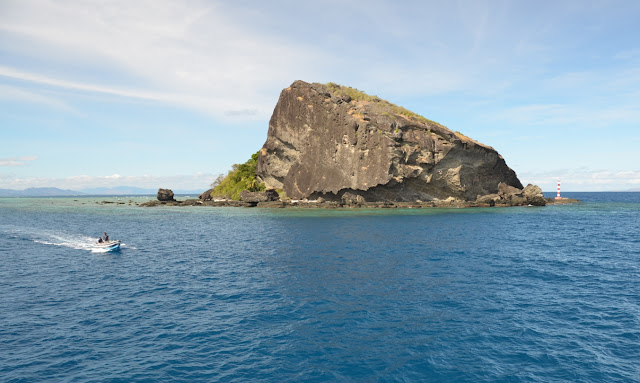It took me more than two solid days of research, poring over numerous topo maps, seeking out clues to the location and reading old newspapers. I am not the first to visit this location and thankfully other folks have not given away enough clues to easily find this mine. I really enjoyed the sleuthing and the reward of seeing the actual mine. If you should figure out the location please do not remove any articles for souvenirs or damage anything! Once the forest rangers decide a mine is an attractive nuisance they will restrict access to it or remove it entirely.
Please join my friend Alan and I on a long and hot day excursion that yielded quite a time capsule of mining history. The terrain was steep and unyielding, the trees tall and the bushes thick. If we had not chanced upon the mining debris field we might never have caught a glimpse of the cabin perched high in a hidden fold of the canyon's wall.
Here is Alan pointing out the first leg of a long and steep descent in remote terrain. It was quite a hike to get to this point above the canyon that jealously guards the old mine's secrets.
We traversed quite a number of narrow and steep gullies as we scoured the rugged canyon.
Suddenly we spotted something man-made, covered in soil and leaves at the bottom of a wash! We carefully uncovered it and it looked to be part of a compressed air distribution system!
As we laboriously pulled ourselves up the slope we spotted an old in-line engine. Either a 4 cylinder with dual plugs or an 8 cylinder. I should have looked at the number of exhaust ports.
Alan is pointing to the still intact glass bowl from the fuel system.
Patent dates on the exhaust manifold show this iron relic to be from the late 1920's!
Amazing how legible the labels are after 90 years.
Here is a smaller 4 cylinder Ford engine. In places this remote it was not feasible to effect major repairs to them on site or haul them out to be repaired in the city. A trip into town was simpler if a new engine was hauled back to the mine and the old engine thrown off the cliff.
Re-energized by these discoveries we found more and more industrial gems that had been cast off from the mining site hidden high above us in the dense forest.
Part of an old compressor.
This is an old mining ore cart, half buried in the debris washing down the gully. I hope to go back and dig it out, setting it in a safer spot so as to better preserve it. At this point in our journey we knew we were very close to the mine!
In the dense brush I see Alan suddenly point uphill. Spotting the corrugated steel of the mine's machinery shed, he gave me an excited shout; "Up there!!"
Wow! Here is the main goal of our hike. How did they ever build this in such a precarious location, long before there were any paved roads to haul in materials and equipment?
Hidden inside was an amazing gas engine-driven Ingersoll-Rand air compressor. We never could figure out how they lowered it down to this spot and later built the shed around it. It is enormous as well as enormously heavy. Note the solid steel spoked wheels.
My guess is that at some point the original engine coolant radiator failed and the resourceful miners rigged up this array of plumbing ppes to act as a crude heat radiator.
The gear driven water pump that fed the radiator
Also in the shed was this old Model 3, American Kamp Kook stove that the tired and hungry miners cooked their meals over.
Here are a couple internet pictures of a crudely repaired Kamp Kook stove. These picures give a sense of how the miner's old stove originally looked way back in the 1920's
So where was the actual gold mine shaft hidden? We started to trace the old compressed air lines across the face of the cliff and soon found one of the mine's adits. Instead of solid steel rails they used a steel overlay on the wood for the ore cart wheels to glide along.
Inside the mine is a bore hole where they would have placed explosives. This is erfect vidence of the compressed air drill that the Ingersoll-Rand compressor once provided motive power to.
To get a better shot of the depth of the adit I used a bright flashlight to penetrate the gloom, hence the different color of light when compared to the camera's flash in the foreground.
I hope that you enjoyed the pictures and the story! I know that Alan and I were very satisfied with our route finding skills and the discovery of so many historical artifacts. Please don't ask me where the site is. It is an important part of the history of Southern California's early growth and needs to remain preserved by its obscurity.
Please educate yourself on the dangers of old mines and caves! Carry safety equipment such as this RKI meter to measure air quality.
I am researching other locations and hope to have a "Part 2" as soon as possible. Until then, tell your friends about this blog and safe travels!


















































